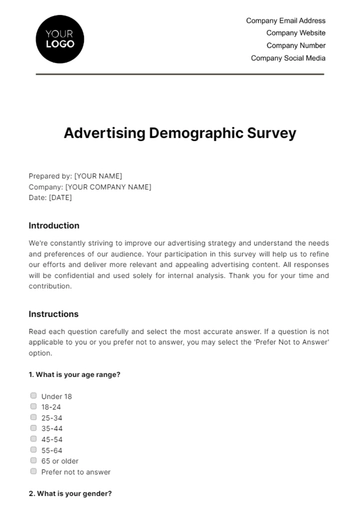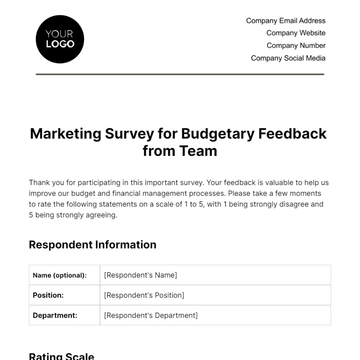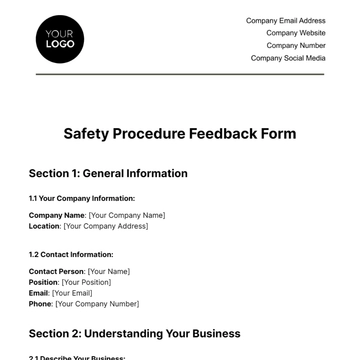Free Professional Research Survey Report

Introduction
This report presents the findings from a comprehensive professional research survey designed to gauge industry trends, assess professional satisfaction, and identify critical factors impacting workplace dynamics in various sectors. Our objective is to provide stakeholders with actionable insights to enhance strategic decision-making.
Methodology
The survey was conducted over a period of three months, from January to March 2023. We utilized a mixed-methods approach to collect both quantitative and qualitative data. The survey was distributed via email to 5,000 randomly selected professionals across different industries, including technology, healthcare, finance, and education. Participants were asked to complete an online questionnaire consisting of 30 questions.
Data Collection
Data was collected through an online platform that ensured anonymity and confidentiality of responses. The response rate was 40%, yielding 2,000 completed surveys. We employed stratified sampling to ensure representation across different sectors and role levels.
Data Analysis
Quantitative data was analyzed using statistical software to identify patterns and correlations. Descriptive statistics were used to summarize the data, while inferential statistics helped in testing hypotheses. Qualitative data underwent content analysis, allowing us to extract themes and insights from open-ended responses.
Findings
Participant Demographics
Category | Percentage (%) |
|---|---|
Gender | Male: 52%, Female: 48% |
Age | 18-24: 15%, 25-34: 35%, 35-44: 25%, 45-54: 15%, 55+: 10% |
Education Level | Bachelor's: 65%, Master's: 25%, Doctorate: 10% |
Industry Sector | Technology: 30%, Healthcare: 25%, Finance: 20%, Education: 15%, Others: 10% |
Industry Trends
The survey revealed several emerging trends across industries. Automation and artificial intelligence continue to drive changes in the technology and finance sectors, while telehealth services are expanding in healthcare. In education, there is a significant shift towards hybrid and online learning models.
Technology: Increased investment in AI and machine learning.
Healthcare: Growth in telehealth and remote patient monitoring.
Finance: Expansion of digital banking services.
Education: Adoption of e-learning platforms.
Professional Satisfaction
Overall job satisfaction levels varied significantly across sectors. The finance sector reported the highest level of job satisfaction at 70%, while education showed the lowest at 55%. Key factors contributing to job satisfaction included work-life balance, remuneration, and professional development opportunities.
Critical Factors Impacting Workplace Dynamics
Participants identified several factors impacting workplace dynamics, including:
Remote Work: A majority expressed a preference for hybrid models, enabling flexibility.
Work-Life Balance: 60% of respondents indicated that maintaining a healthy work-life balance was crucial for their satisfaction.
Career Advancement: Opportunities for professional growth and skill enhancement were vital for job retention, with 75% of participants expressing this view.
Organizational Culture: A positive work culture was linked to higher levels of commitment and productivity.
Discussion
The findings underscore the need for organizations to adapt to changing industry dynamics and employee expectations. Embracing technology, providing professional development opportunities, and fostering a supportive organizational culture are essential strategies for enhancing employee satisfaction and retention.
Furthermore, the continued development of flexible work arrangements could be a key differentiator in attracting and retaining top talent.
Conclusion
The research survey provided valuable insights into industry trends and professional satisfaction across various sectors. Organizations should use these findings to inform their strategic planning and human resources practices, ensuring alignment with current trends and employee expectations. By addressing the critical factors highlighted, businesses can improve workplace dynamics, drive productivity, and achieve sustainable growth.
- 100% Customizable, free editor
- Access 1 Million+ Templates, photo’s & graphics
- Download or share as a template
- Click and replace photos, graphics, text, backgrounds
- Resize, crop, AI write & more
- Access advanced editor
Streamline your research with Template.net's Professional Research Survey Report Template! Fully editable and customizable, this template empowers you to craft comprehensive reports effortlessly. Utilize the built-in AI Editable Tool for quick modifications, saving time while ensuring precision. Ideal for researchers, it guarantees professional, tailored results every time. Simplify your workflow and deliver excellence with ease!





























